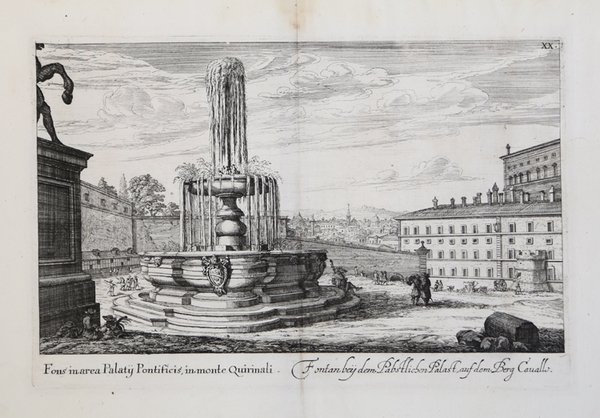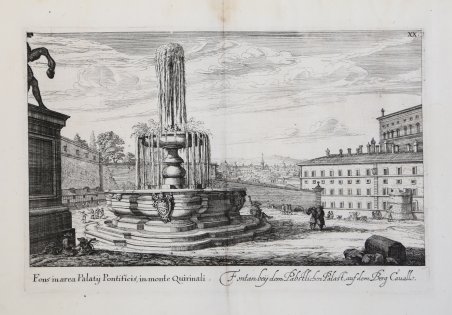Opera tratta dalla celebre ' Academia Todesca della Architectura, Scultura & Pittura: oder Teutsche Academie der Edlen Bau, Bild-und Mahlerey-Künste, raccolta monumentale, riccamente illustrata da centinaia di incisioni raffiguranti antichità, architettura e mitologia classica, edita a Norimberga e Francoforte tra il 1675 ed il 1680. ' Questo lavoro di Sandrart, pubblicato con il titolo Romanorum Fontinalia Sive Nitidissimorum Perenniumque, Intra & Extra, Urben Roman, deriva dalla serie Le Fontane di Roma di Giovan Battista Falda edita da Giovanni Giacomo de Rossi alla Pace, in 4 volumi, intorno al 1680. Falda, che muore a Roma nel 1678, incise le tavole del primo e del secondo volume, intitolati rispettivamente dal titolo Le Fontane di Roma nelle Piazze, e Luoghi Publici Della Citta e Le fontane delle ville di Frascati, nel Tusculano. Le tavole del terzo e quarto volume, Le fontane ne' palazzi e ne' giardini di Roma e Le fontane del giardino Estense in Tivoli, furono, invece, incisi da Giovani Francesco Venturini. Per le sue incisioni, il Sandrart si avvalse dei suoi collaboratori Karl Gustav von Amling (1650-1703); Philip Kilian (1628-1693); Richard Collin (1627-97); Georg Andreas Wolfgang (1631-1716); Johann Georg Waldreich (d.1680); Melchior Küsel (1626-1683); Franck, Johann (fl.1659-1690); George Christoph Eimmart (1638-1705); Susanna Maria von Sandrart (1658-1716); Bartholomäus Kilian (1630-1696). L'opera è piena di illustrazioni di edifici romani antichi e moderni, scultura, teoria della pittura, biografie di artisti, tra cui artisti tedeschi e contemporanei (cioè del XVII secolo), e antichità. Joachim von Sandrart fu un pittore di una certa importanza, ma è per la sua Teutsche Academie che è principalmente ricordato. Il suo compendioso trattato include sezioni sulla scultura antica e l'architettura, la prospettiva, la teoria della pittura, biografie di artisti, una traduzione delle Metamorfosi di Ovidio e così via. La seconda parte del Libro I pretende di dare una storia dell'arte dalle sue prime origini, e si apre con un'incisione di due scene di racconti leggendari della scoperta del disegno. L'opera è dedicata alla nazione tedesca di fama mondiale e ai campioni e amanti dell'arte ('Der Welt-berühmten Teutschen Nation . Kunst-Helden und Kunstliebenden'). Acquaforte, con margini, ottimo stato di conservazione. Bibliografia National Gallery (Washington), ' Mark J. Millard, III (1998), no. 111; F.W. H. Hollstein, ' German engravings . ca. 1400-1700 ' (1954-), 38-41; Anna Schreurs, ' Unter Minerva schutz: bildung durch kunst in Joachim von Sandrarts 'Teutscher Academie' ' (2012). Plate taken fom the monumental ' Academia Todesca della Architectura, Scultura & Pittura: oder Teutsche Academie der Edlen Bau, Bild-und Mahlerey-Künste ' (Deutsche Academy of Architecture - Sculpture – Painting). ' This work by Sandrart, published under the title Romanorum Fontinalia Sive Nitidissimorum Perenniumque, Intra & Extra, Urben Roman, derives from the series Le Fontane di Roma by Giovan Battista Falda published by Giovanni Giacomo de Rossi alla Pace, in 4 volumes, around 1680. Falda, who died in Rome in 1678, engraved the plates of the first and second volume, entitled respectively Le Fontane di Roma nelle Piazze, e Luoghi Publici Della Citta and Le fontane delle ville di Frascati, nel Tusculano. The plates of the third and fourth volume, Le fontane ne' palazzi e ne' giardini di Roma and Le fontane del giardino Estense in Tivoli, were instead engraved by Giovani Francesco Venturini. The first edition, in German, was published by Joachim von Sandrart in Nuremberg, in three volumes respectively in 1675, 1679 and 1680. For the plates Sandrart used his students as and many others artist as Karl Gustav von Amling (1650-1703); Philip Kilian (1628-1693); Richard Collin (1627-97); Georg Andreas Wolfgang (1631-1716); Johann Georg Waldreich (d.1680); Melchior Küsel (1626-1683); Franck, Johann (fl.1659-1690); George Christoph Eimmart (1638-1705); Susanna Maria von Sandrart (1658-1716); Bartholomäus Kilian (1630-1696). The work is full of illustrations of ancient and modern Roman buildings, sculpture, the theory of painting, biographies of artists, including German and contemporary (ie seventeenth-century) artists, and antiquities. Joachim von Sandrart was a painter of some note but it is for his Teutsche Academie that he is chiefly remembered. His compendious treatise includes sections on ancient sculpture and architecture, perspective, the theory of painting, artists’ biographies, a translation of Ovid’s Metamorphoses and so on. The second part of Book I purports to give a history of art from its earliest origins, and opens with an engraving of two scenes of legendary accounts of the discovery of drawing. The frontispiece to Volume I is signed as drawn by J. de Sandrart and engraved by C.G. Amling; that of Volume II is signed as drawn by Sandrart and engraved by R. Collin. The portrait in Volume I is signed as painted by J.U. Mair and engraved by P. Kilian; that in Volume II is signed as engraved by R. Collin. Many plates are signed as drawn by Sandrart and engraved by R. Collin or other engravers (J. Franck, G.A. Wolfgang, J.G. Waldreich, I.I. Thourneyser, Melchior Küsell, G. C. Eimmart, B. Kilian, Jacob Sandrart, Joh. Meyer, Susanna von Sandrart, J.A. Boener, C. Meyer). Many plates are unsigned. The work is dedicated to the world-renowned German nation and to champions and lovers of art ('Der Welt-berühmten Teutschen Nation . Kunst-Helden und Kunstliebenden'). Etching with margins, very good condition. References National Gallery (Washington), ' Mark J. Millard, III (1998), no. 111; F.W. H. Hollstein, ' German engravings . ca. 1400-1700 ' (1954-), 38-41; Anna Schreurs, ' Unter Minerva schutz: bildung durch kunst in Joachim von Sandrarts 'Teutscher Academie' ' (2012). Cfr.


Découvrez comment utiliser
Découvrez comment utiliser

